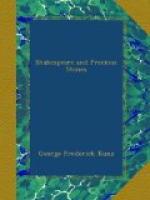In commemoration of the Tercentenary of Shakespeare’s death, the Shakespearean scholar, Miss H.C. Bartlett, prepared for the New York Public Library an exhibition of Shakespearean books, including all the early editions of the quartos; the various editions of the folios; the works of contemporaneous authors whom Shakespeare had consulted; and also the early works that mention Shakespeare, or cite from his plays or poems, including Greene’s “Groat’s Worth of Wit”, published in 1592 by Henry Chettle and containing the earliest printed allusion to Shakespeare under the name of “Shake-scene”.
One of the contemporary books containing citations from Shakespeare’s works, shown at the New York Public Library, is “The Woman Hater”, by Francis Beaumont (?1585-1615 or 1616), printed in 1607.[11] The citation, from Hamlet, Act i, sc. 5,[12] is apropos of the disappearance of a “fish head”. It is put into the mouths of two of the characters, as follows:
Lazarello.
Speak, I am bound to hear.
Count.
So art thou to revenge when thou shalt hear.
[Footnote 11: “The Woman Hater, as it hath beene lately acted by the children of Paules, London, printed and to be sold by John Hodgers in Paules Church-yard, 1607".]
[Footnote 12: First Folio, p. 257, col. B, lines 15, 16.]
In the spacious hall of the beautiful Hispanic Museum in New York City there has recently been displayed, in commemoration of the tercentenary of Cervantes’s death, an exceptionally fine collection of editions of his works and of rare plates illustrating episodes from them. Notable among the books was a first edition of his earliest published poems, four redondillas, a copla and an elegy, on the death, October 3, 1568, of Elizabeth de Valois, third wife of Philip II, and sister of Charles IX of France.[13] Dark rumors were afloat for some time that she had been poisoned by order of her husband. Among the other treasures in the Hispanic Museum exhibition was the earliest imprint of Cervantes’s masterpiece, the immortal “Don Quixote”. This was printed in Madrid, in 1605, by Juan de la Cuesta.
[Footnote 13: The compilation containing these poems is entitled: “Hystoria y relacio verdadera de la enfermedad felicissimo transito y sumptuosas exequias funebres de la Serenissima Reyna de Espana Isabel de Valoys nuestra Senora”, Madrid, 1569. The opening lines of Cervantes are:
A quien yra mi doloroso canto O en cuya oreja sonara su acento? (To whom will my sad song go, and in whose ears will its accents sound?) ]
A rather attractive bit of verse, purporting to have been written by Shakespeare and dedicated to the woman who became his wife in 1582, when he was but eighteen years old (she was eight years his senior), alludes in its third stanza to “the orient list” of gems, diamond, topaz, amethyst, emerald, and ruby. This little poem, with its play upon the lady-love’s name, can find a place here, although many readers are already familiar with it.




